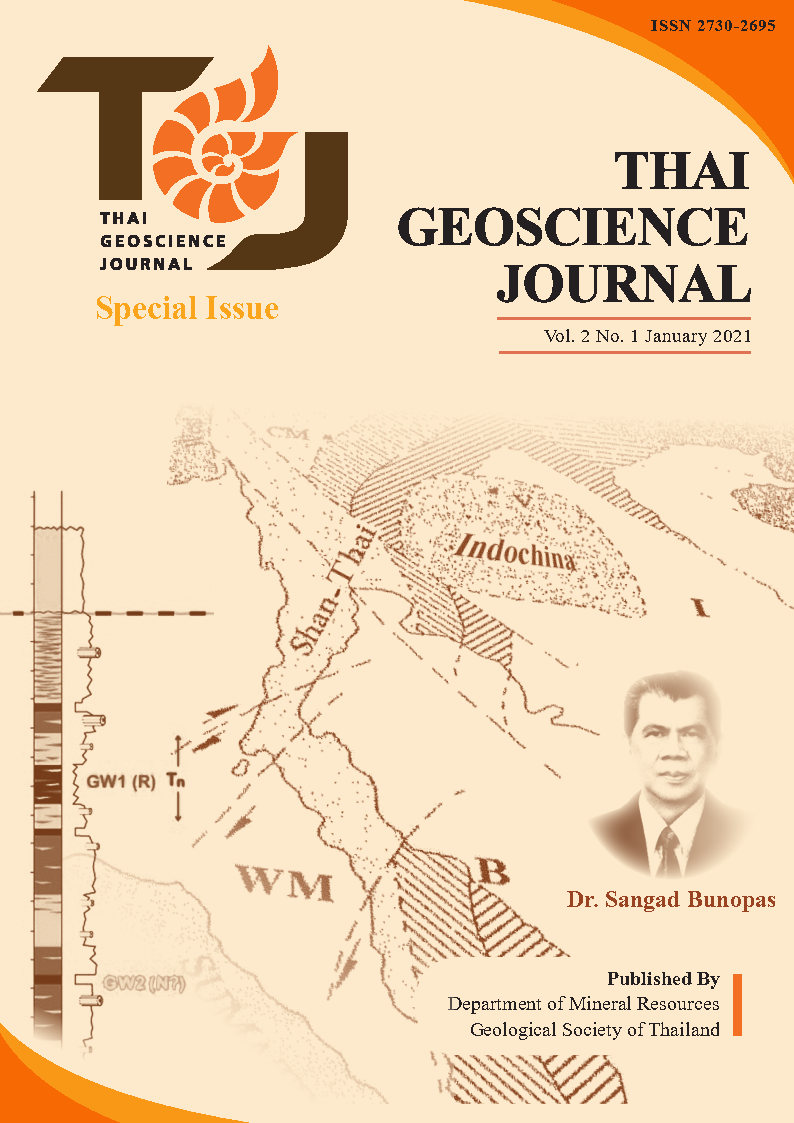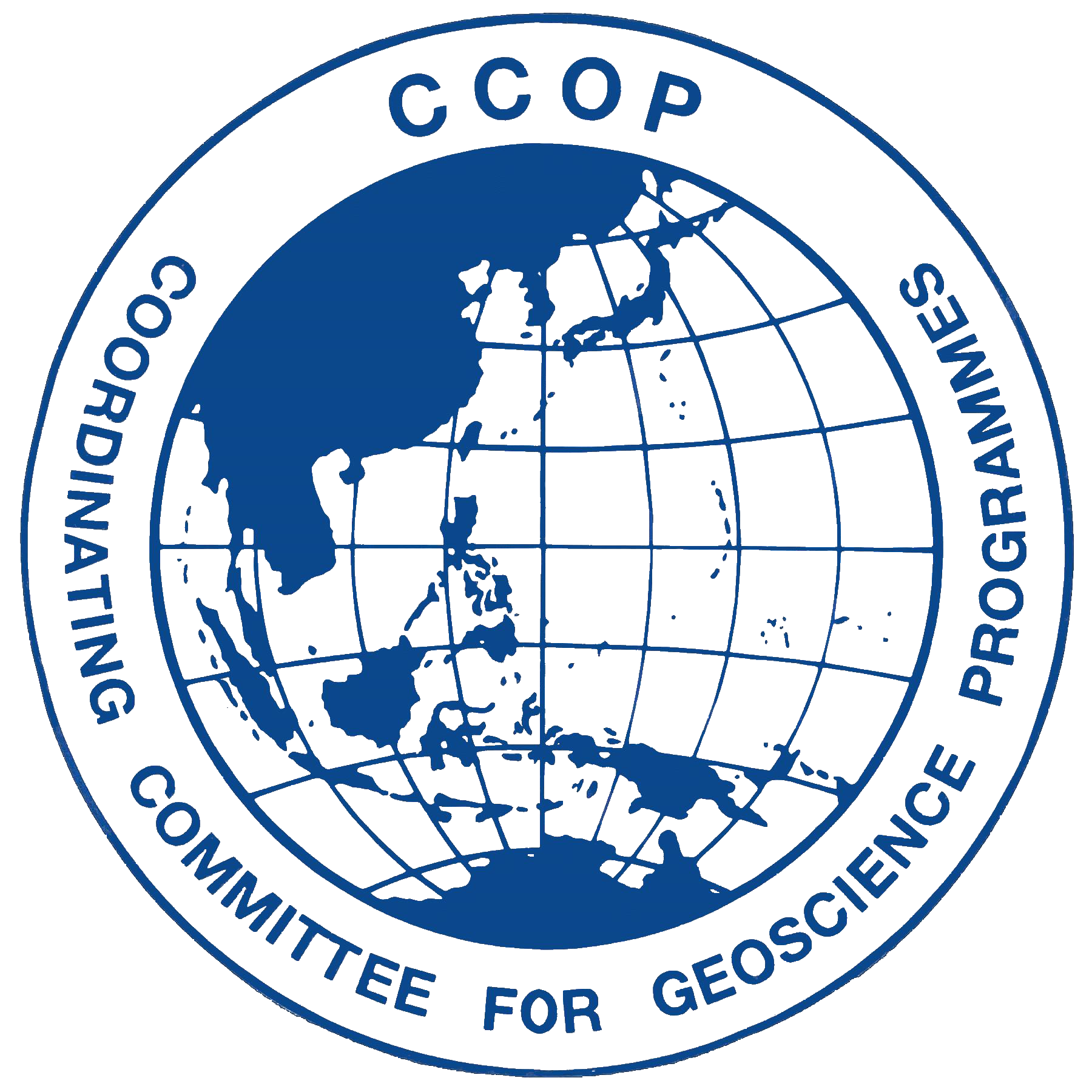Australasian Pleistocene cometary impact and its effects in Thailand
Keywords:
burnt trees, cometary impact, loess, megaflood sediments, Quaternary, Shan-Thai Terrane, tektites, wildfireAbstract
Tektites are silica-rich glasses distributed in 4 strewn fields around 3 definite impact craters in the USA, Ghana and Germany and the Australasian strewn field around possibly one or more craters in Indochina. The distribution, morphology, size, mineralogy, geochemistry and contained gases of Australasian tektites confirms their terrestrial origin from a sandstone target rock of approximately Jurassic age and an impact site or sites within or offshore Indochina. The Indochina impact is dated at about 788 ka. Layered tektites are known from a more limited area and probably are proximal to the impact crater or craters. The largest layered tektites weigh up to 24 kg and come from Ubon Ratchathani Province in NE Thailand or perhaps from neighbouring Laos. Dumbbell, spherical, teardrop and disc shaped splash-form tektites are found across SE Asia and southern China. Aero-ablated tektites (australite buttons) extend to the Indian Ocean and Australia and microtektites are found in Antarctica and in deep-sea cores from the Indian Ocean and the marginal seas of the western Pacific. In many deep-sea cores, microtektites occur just below the Matuyama-Brunhes magnetic reversal dated at about 772.9 ± 5.4 ka. and occur with high pressure minerals such as coesite. Coesite and reidite along with silt-size detrital minerals within layered tektites are conclusive evidence of an impact origin. The abundance and distribution of iridum and microtektites in ocean cores has led several authors to calculations of a single crater size of between
15 km and >120 km with a most likely diameter of about 40 + km.
Both layered tektites and splash-form tektites occur at the junction of laterite and a loess-like sand or rarely within the loess, across much of SE Asia and this stratigraphic relationship is especially clear on the Khorat Plateau in NE Thailand. The widespread loess is different to typical Chinese loess, is palaeoclimatically anomalous and is considered herein as ‘catastroloess’ – the result of the 788 ka impact event.
Unreworked, tektites, including one very fragile hollow sphere, are also found in fluvial sands dated by thermoluminescence as 748 ka in Nakhon Ratchasima (Khorat) Province along with large, unusually very abundant charcoalified and partially charcoalified trees and smaller plant matter such as bamboo. This section of the sandpits along the palaeo-Mun River contains Pleistocene vertebrates in the upper sections and Miocene vertebrates below the tektite horizon. The tektite horizon occurs close to the Matuyama-Brunhes magnetic reversal. The sandpits are argued to contain globally unique evidence of a large extraterrestrial impact event.
Impact craters and abundant impact glasses at the Zhamanshin crater in Kazakhstan (c. 920-650 ka) and at the Darwin Crater in Tasmania, Australia (816 ± 7 ka) are argued to be contemporaneous with the Australasian strewn field and the result of a comet travelling southeastwards and disintegrating, creating catastrophic impacts first in Kazakhstan, then in Indochina and finally in Tasmania. This hypothetical trail of impacts is comparable to the disintegration and multiple impacts of the Shoemaker-Levy comet fragments into Jupiter’s atmosphere in 1994.
These multiple impacts on Earth would have had profound effects on faunas, climate and sedimentation along the comet’s path including on our immediate ancestor Homo erectus in China, in Java and possibly in Lampang and Nan in Thailand. More evidence of impact in Thailand may be present near Nan and Phrae in northern Thailand and at Sra Kaeo in eastern Thailand where sao din or earth pillars are eroded ‘catastroloess’ and at Bo Phloi in western Thailand where sand-pits contain abundant charcoalified logs. Large trees within river terrace gravels at Khorat (with a tektite) and at Tak in NW Thailand may also be due to the impact.
Other proposed impact effects on probable Miocene fish mortality in Phetchabun, MiocenePleistocene mammal mortality in Australia, probably Holocene shell-beds around Bangkok and the Inthanon Uplift in northern Thailand should be considered but are more speculative.
References
SUGGESTED FURTHER READING
Barnes, V.E. and Pitakpaivan, K. 1962: Origin of Indochinese tektites. Proceedings of the National Academy of Science USA. 48, 947-955.
Chaimanee, Yaovaluk, 2004. Fossils from Khok Soong and Ban Tha Chang, Khorat. In: Numerous fossils in Paleontology of Thailand, in 114 years of the Department of Mineral Resources. (in Thai)
Duangkrayom, J., Ratanasthien, B., Jintasakul P., Carling, P.A. 2014. Sedimentary facies and paleoenvironment of a Pleistocene fossil site in Nakhon Ratchasima province, northeastern Thailand. Quaternary International 325: 220–238. doi: 10.1016/j.quaint. 2013.07.048
Glass, B.P., Folco, P., and Campanale, F., 2020 Coesite in a Muong Nong-type tektite from Muong Phin, Laos: Description, formation, and survival. Meteoritics & Planetary Science 1–21, doi: 10.1111/maps.13433
Haines, P. W., K. T. Howard, J. R. Ali, C. F. Burrett, Sangad Bunopas, 2004. Flood deposits penecontemporaneous with 0.8 Ma tektite fall in NE Thailand: impact-induced environmental effects? Earth and Planetary Science Letters 225 , 19-28.
Howard, K. T. 2004: Origin of Darwin Glass. Unpublished Ph. D. Thesis, University of Tasmania, Australia. 362 pp
Howard, K.T., 2011. Tektites in: Ridd, M.F., Barber, A.J., Crow, M.J. (Eds.), The Geology of Thailand, The Geological Society of London, pp. 574-591. DOI:https://doi.org/10.1144/GOTH.21
Howard, K. T., P. W. Haines. C. F. Burrett, J. R. Ali, S. Bunopas, 2003. Sedimentology of 0.8 Ma log-bearing flood deposits in northeast Thailand and mechanisms for pre-flood deforestation, Proceedings, 8th International Congress on Pacific Neogene Stratigraphy, Chang Mai, Thailand, 2003, pp. 49-67.
Koeberl C., 1994. Tektite origin by hypervelocity asteroid or cometary impact: Target rocks, source craters and mechanism. In Large Meteorite Impact and Planetary Evolution (eds. B. O. Dressler, R. A. F. Grieve and V. L. Sharpton), pp. 133-151. Geol. Soc. Am. Spec. Pap. 293, Boulder, Colorado.
McCall, G.J.H. 2001. Tektites in the Geological Record: Showers of Glass from the Sky.: London (The Geological Society), 2001, viii + 256 pp. ISBN 1 86239 085 1.
Nichol, J.E., Nichol, D. W., 2015. Character and provenance of aeolian sediments in northeast Thailand. Aeolian Research, 19, 5-14. https://doi.org/10.1016/j. aeolia.2015.09.001
Sieh, S., Herrin, J., Jicha, B., Schonwalder, D., Moore, J., Banerjee, P., Wiwegwin, W., Sihavong, V., Singer, B., Chualaowanich T., and Charusiri, P., 2020. Australasian impact crater buried under the Bolaven volcanic field, Southern Laos. Proceedings of the National Academy of Science, 117 (3) 1346-1353; https://doi.org/10.1073/ pnas.1904368116
Suraprasit K, Jaeger J-J, Chaimanee Y, Chavasseau O, Yamee C, Tian P, Panha S. 2016. The Middle Pleistocene vertebrate fauna from Khok Sung (Nakhon Ratchasima, Thailand): biochronological and paleobiogeographical implications. ZooKeys 613: 1–157. doi: 10.3897/zookeys.613.83
Wasson, J. T., 1985. Meteorites: Their Record of Early Solar System History, Freeman, New York.
Wasson, J. T., Pitakpaivan, K., Putthapiban, P., Salyapongse, S., Thathimthong, B., and McHorne, J. F. 1995. Field recovery of layered tektites in northeast Thailand: Evidence of a large scale melted sheet. J. Geophys. Res., 100. 14385-14390.
Yang, F-C., & Grote P.J., 2018. Riverine vegetation and environments of a Late Pleistocene river terrace, Khorat Plateau, Southeast Asia. Palynology, 42:2, 158-167, doi: 10.1080/01916122.2017.1296044
REFERENCES AND BIBLIOGRAPHY
Abbott, M. J., and Chamalaun, F. H. 1981. Geochronology of some Banda Arc volcanics. Indonesia Geological Research and Development Centre Special Publication 2, 253-68.
Achache, J. and Courtillot, V. (1987). A preliminary Upper Triassic paleomagnetic pole for the Khorat Plateau (Thailand): consequences for the accretion of Indochina against Eurasia. Earth and planetary Science Letters 73, 147-57.
Achache, J., Courtillot, V., and Besse, J. 1983. Paleomagnetic constraints on the Late Cretaceous and Cenozoic tectonics of Southeast Asia. Earth and Planetary Science Letters 63, 123-136.
Achache, J., Courtillot, Y., Zhou,Y. X. , Lu, L.Z.,and Yuan, X. G. (1982). The paleolatitude and geographic extent of sourhern Tibet in Middle Cretaceous-new palaeomagnetic data. Palaeomagnetic research in Southeast and East Asia, C. C. O. P/Tp 13, Bangkok, 47-57.
Acharyya, S. K. (1978). Mobile belts of the Burma-Malaya and the Himalaya and their implications on Gondwana and Cathaysia/Laurasia continent configurations. Geology and mineral resources of Southeast Asia (ed. Prinya Nutalaya), pp. 121-7. Asian Instit. Technology, Bangkok.
Adam, D. P., 1988. Developing for a climate record for the past three million years. United States Geological Survey Year Book Fiscal Year 1988. United States Printing Office, 1989. 134 pp., 50 - 52.
Adams, E. W. and Huffaker, R. M., 1964. Aerodynamic analysis of the tektite problem. Geochim. Cosmochim. Acta 28, 881-892.
Adinegoro, U. and Hartoyo, P. (1974). Paleogeography of northeast Sumatra. Proceedings of the Indonesian Petroleum Association Third Annual Conuention, Jakarta, June 1974, 45-52.
Aghassi, B. 1962. Astro. Contrib. Boston Univ., ser II, No. 6, 8 pp.
Ahrendt, H., C. Chonglakmani, B. T. Hansen, and D. Helmcke 1993. Geochronological cross section through northern Thailand, J. SE Asia Earth Sc., 8, 207-2 17, 1993.
Alderson, A; Holmes, M. A. and Murphy, C., 1994. A summary of the biostratigrahy and biofacies for the Tertiary sequence, Gulf of Thailand. Proc.of the Intern. Symp.on Stratigraphic Correlation of SE Asia. 15-20 Nov. 1994, Bangkok, Thailand.
Aldiss, D. T. and Ghazali, S. A. (1934). The regional geology and evolution of the Toba volcano-dipression, Indonesia. Journal of the Geological Society London 141,487-500.
Allen, C. R. 1952. Circum-pacific faulting in the Philippines -Taiwan region. Journal of Geophysic Research 67,4795-812.
Allen, C. R., Gillespie, A. R., Han Yuan, Sieh, K. E.. Zhang Buchun, and Zhu Chengna. 1984. Red River and associated faults Yunnan Province, China: Quaternary geology, slip rates and seismic hazard- Geological Society of America Bulletin 95. 686-700.
Alexander, J. B. (1958). The geology and mineral resources of the neighbourhood of Bentong, Pahang, and adjoining porrions of Selangor and Negri Sembilan. Memoirs of the Geological Survey Department West Malaysia 8, Ipoh.
Alexseev, M. N. and Takaya, Y., 1967. An outline of the Upper Cenozoic deposits in the Chao Phraya basin, Central Thailand. Southeast Asia Studies. V. 5, no. 2, pp. 106-124
Alvarez, W., 1986. Towards a theory of impact crises. EOS Trans. AGU, 67 (no. 35) 649, 653-655. 658.
Alvarez, W., Alvarez, L. W., Asaro, F. and Michel, H. V., 1979, 1979a. Experimental evidence in support of an extra-terrestrial trigger for the Cretaceous-Tertiary extinctions (abstract), EOS Trans. AGU, 60, 734.
Alvarez, W., Alvarez, L. W., Asaro, F. and Michel, H. V.,1979b Anomalous iridium levels at the Cretaceous-Tertiary boundary at Gubbio, Italy: Negative tests for a super nova origin. In T. Birkelund (ed.) Cretaceous-Tertiary Boundary Events Symposium, 2, 69, University of Copenhagen, Copenhagen. Alvarez, L. W.,
Alvarez, W., Asaro, F. and Michel, H. V., 1980. Extrateresstrial cause for Cretaceous-Tertiary extinction. Science, 206, 1095-1107.
Anderson, R.N., 1980. Update of heat flow in the East and Southeast Asian seas and islands. Am, Geophys. Union Geophys. Monogr. Ser., 23, 319-326.
Armijo, R., P. Tapponnier, J. L. Mereier, and H. Tonglin 1986. Quaternary extension in southern Tibet : field observations and tectonic implications, J. Geophys. Res., 91, 13,803-13, 872,1986.
Armijo, R., P. Tapponnier, and H. Tonglin, 1989. Late Cenozoic right-lateral strike-slip faulting in southern Tibet, J. Geophys. Res., 94, 2787-2838, 1989.
An, Z. S.. Wang, J. D. & Li, H.M., 1977. Paleomagnetic research of the Luchuan loess section. Geochimica 4, 239-249. (in Chinese with English abstract)
Anderson, J. B.. 1983: Ancient glacial-marine deposits: Their spacial and temporal distribution. In Molnia, B.E (ed.): Glacio-marine sedimentation. Plenum Press, New York, p. 3-92.
Angier, N. Reported by R. Burderi, B. and C.Gorman, 1985. Did Comets Kill the Dinosaurs? Science Section, TIME, May, 1985, 50-61.
Archibald, J. D. and Clemens, W. A.., 1982. Late Cretaceuos extinction. Amer. Sci. 70, 377-385.
Arpandi, D. and Patmosukismo, S. (1975). TheCibulakan Formation as one of the mosr prospective stratigraphic units in the northwestJava bisinal area. Proceedings of the Indonesian petroleum Association l, 1,81-211.
Aitchison, J. C. and A. M. Davis, 2001. When did the India - Asia Collision Really Happen? Gondwana Research, 4 (4) 2001: 460-461.
Asaro, F., Alvarez, L., Alvarez, W. and Michfi, Fl. 1982. Geochemical anomalies near the Focene/Oligoceene and Permian - Triassic boundaries. GSA Spec. Paper 190, 517-528.
ASCOPE (1981). Tertiary sedimentary basins of the Gulf of Thailand and South China Sea: stratigraphy, structure and hydrocarbon occurrences. ASEAN Council on Petroleum, Jakarta.
Audley-Charles, M. G., 1987. Dispersal of Gondwanaland: relevance to evolution of the angiospcrms. In: Biogeographical Evolution of the Malay Archipelago’. (Ed. T. C. Whitmore.) 5-25. (Clarendon Press: Oxford.)
Audley-Chartes, M. G., 1988, Evolution of the southem margin of Tethys (North Australia region) from the Early Permian to Late Cretaceous, in Audley-Charles, M., and Hallam, A., eds., Gondwana and Tethys: Geological Society of London Special Publication 37, p. 79-l00.
Audley-Charles, M. G., Carter, D. J., and Milsom, J. S. (1972). Tectonic development of eastern Indonesia in relation to Gondwanaland dispersal. Nature, London (Physical Science) 239, 35-9.
Aylmer, D,, M. Guyton. G.F. Herzog, B.M. Clement, i. Klein and R. Middleton. Beryllium-IO contents of sediments associated with the Matuyama- Brunhes geomagnetic reversal (abstract). Trans. Am. Geophys. Union 69, 34t. 1988.
Downloads
Published
How to Cite
Issue
Section
License
Copyright (c) 2021 Thai Geoscience Journal

This work is licensed under a Creative Commons Attribution-NonCommercial-NoDerivatives 4.0 International License.








